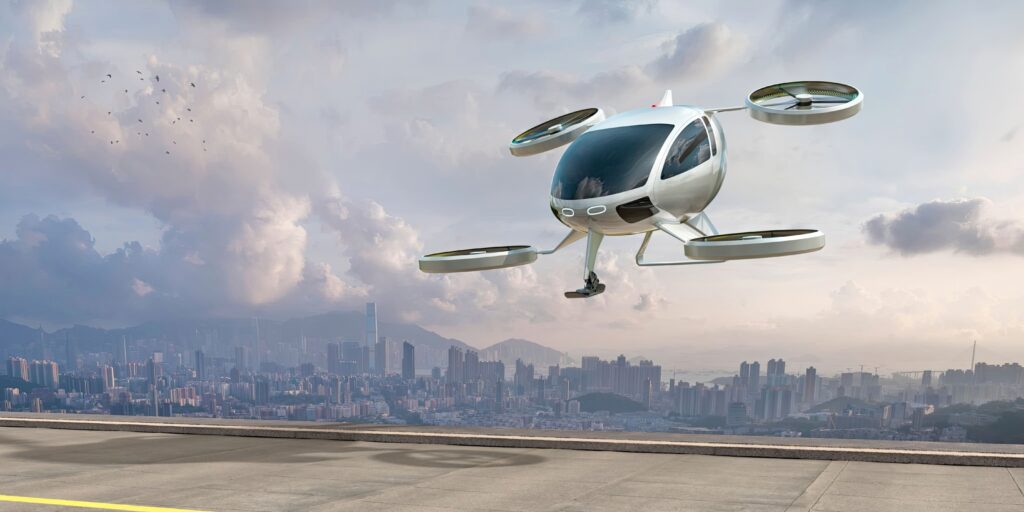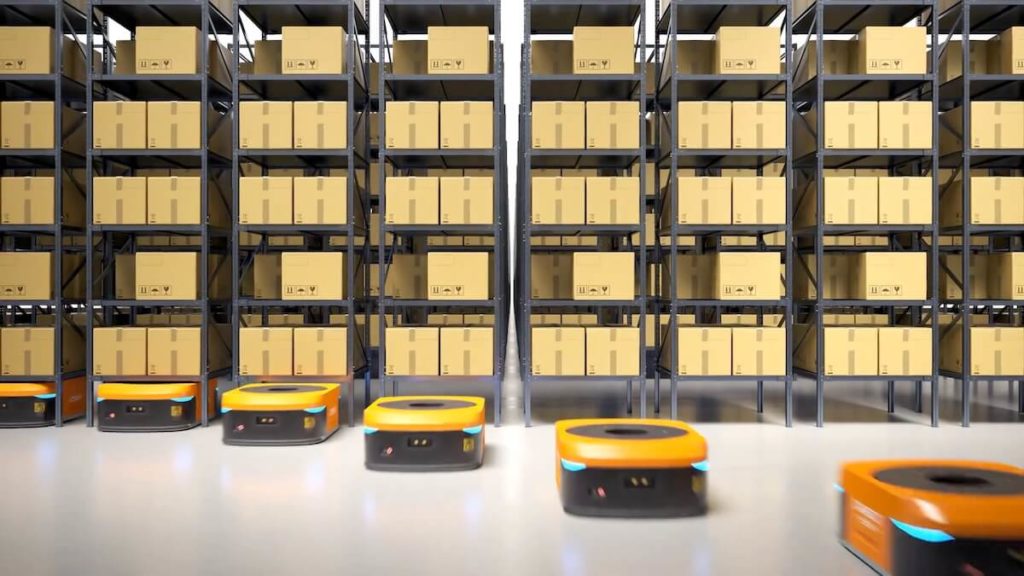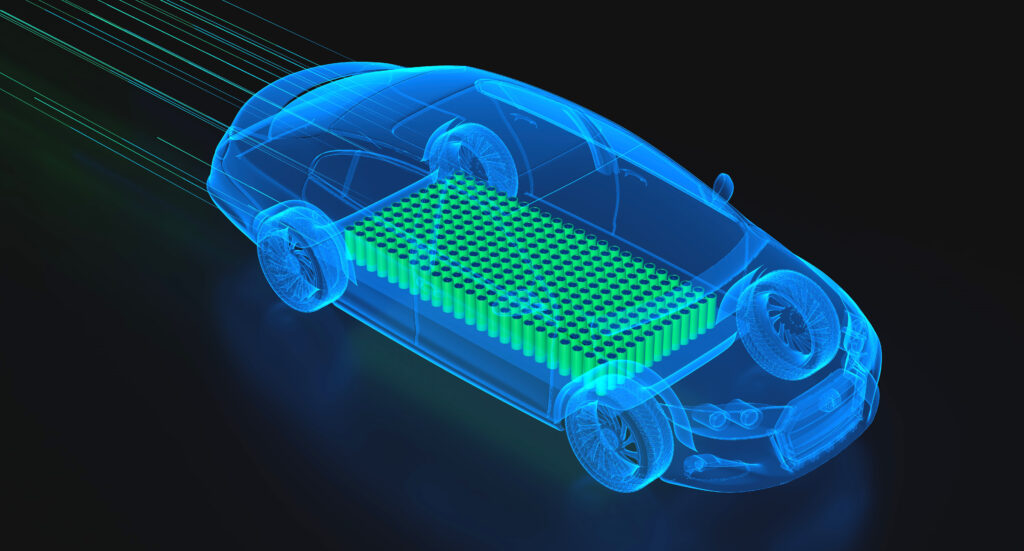Exponential technologies never emerge in isolation. They collide and combine to create opportunities far more valuable than any single breakthrough. A better digital camera is nice, but add smartphones and social networks and you get Instagram; a faster computer chip is great, but feed it massive datasets and AI algorithms and you get ChatGPT. These collisions are “convergence effects,” and they’re often where the greatest treasures lie.
Consider the story of Arista Networks. In 2020, Arista was a maker of high-speed networking gear – solid tech, but nothing flashy. Then, over the next few years, its stock price soared nearly tenfold by sitting at the intersection of AI and cloud computing. As companies raced to build ever-larger AI models, they hit an unexpected bottleneck: you can stack more NVIDIA GPUs into a data center, but if those chips can’t exchange data fast enough, they sit idle. Arista’s ultra-fast networking hardware, originally built for latency-sensitive stock trading, was uniquely suited to remove that data traffic jam. Without changing their core product, Arista suddenly became essential plumbing for the AI revolution.
Sometimes, simply “being at the right place at the right time” – at the critical intersection of two booming trends – can create outsized value. Below, we’ll unpack four patterns for systematically identifying convergence effects and the companies poised to benefit. We’ll then explore some of the key collisions happening now and on the horizon.

How to Spot Convergence Effects
Not every mash-up of technologies results in something useful. Buzzwords from multiple domains doesn’t make a convergence winner. To discern real synergies from “franken-tech” marketing hype, there are four key patterns to watch for:
Follow the Bottlenecks
Convergence opportunities often emerge when one exponential technology runs up against the limitations of another. An innovation chain is only as strong as its weakest link, and exponential growth can only move as fast as the current bottleneck allows. In other words, find the bottleneck, find the opportunity.
Arista Networks was a textbook example of this pattern. As AI model sizes exploded, the bottleneck shifted from computing power to data networking. Chips were waiting on data transfer speeds. Arista offered a fix and was richly rewarded. The broader lesson: when one part of a system goes exponential, the next part that struggles to keep up becomes the opportunity.
One way to anticipate bottlenecks is to visualize each technology as a “stack” of layers. Take the AI ecosystem as an example:
- At the top you have AI applications (say, a ChatGPT-powered service).
- Beneath that are the AI models and training algorithms, which depend on enormous datasets.
- Those run on powerful computing hardware (e.g. NVIDIA GPUs), which rely on high-speed networking to shuffle data between processors.
- Underpinning it all are memory and storage to hold the data, and the power and cooling infrastructure to keep the whole data center running.
If any layer in this stack can’t scale up as fast as the others, it becomes the choke point. Thus, we can examine each layer and ask: What breaks if the other layers demand 10× more?
For instance, AI models are growing ever larger and more complex. That’s revealing new bottlenecks in areas like memory bandwidth and energy consumption. In fact, the current slowdown in AI training speed is due in part to the “Memory Wall” – the gap between how fast processors improve versus memory systems. Companies that crack these limitations, perhaps through new high-bandwidth memory technologies or more efficient chip architectures, could become the next big winners.
This bottleneck analysis can be applied to any exponential tech sector. In electric vehicles, for example, Tesla realized early on that the car itself wasn’t the only hurdle to mass adoption. If millions of EVs hit the road, would there be enough battery supply, charging stations, and grid capacity to support them? Tesla aggressively invested in the entire stack, from scaling battery production to building a nationwide fast-charging network.

Follow the (Big Tech) Money
The largest tech companies often see convergence opportunities before anyone else. They have to; their immense scale means they encounter growth limits first, and they have the resources and incentive to seek out fixes early. If Google, Amazon, Apple, or Microsoft start making unusual investments or strategic supplier deals, it can be a clue that they’re betting on a convergence trend.
For instance, years before the current AI boom, Microsoft was already standardizing its data centers on Arista’s network switches. Microsoft’s engineers foresaw that as cloud and AI workloads grew, conventional networking gear wouldn’t cut it. By the time AI exploded into the mainstream, Microsoft (and similarly, Meta/Facebook) had locked in their critical infrastructure suppliers.
Today, we can synthesize a picture from the moves top companies are making. Look at how the tech giants are positioning themselves:
- Microsoft’s multi-billion-dollar partnership with OpenAI (and hefty cloud spending to support it)
- Google and IBM pouring money into quantum computing research facilities
- Amazon buying into healthcare and pharmacy infrastructure
- Several leaders placing big bets on next-gen energy (from advanced batteries to small nuclear reactors and even fusion)
These investments signal where these firms see the future. But the real insights for investors come from digging one layer deeper: watching their behind-the-scenes commitments. Which suppliers are they choosing and signing multi-year deals with? Where are they quietly spending on capacity, talent, or exclusive partnerships? If a mega-cap is strategically aligning with a smaller player for the long haul, that smaller player likely sits at a valuable convergence point.
A classic example is how Apple quietly shifted its most advanced chip production to TSMC (Taiwan Semiconductor) around 2014. At the time, Intel and Samsung were the household names in chips, but Apple saw TSMC pulling ahead in manufacturing prowess and bet its future on that supplier. Today TSMC is indispensable to the entire semiconductor industry, in no small part thanks to early vote of confidence (and large orders) from a leader like Apple.
The broader point: follow the money of industry leaders. They invest where they anticipate constraints or breakthrough synergies. So if multiple big players all make moves in the same “obscure” area – be it a type of sensor, material, or niche software – chances are, it’s not obscure to them at all.
Watch for “Adjacent Possible” Moments
Sometimes, a technology that’s been around for years suddenly becomes hugely in demand when another technology reaches maturity. These “adjacent possible” innovations were technically possible (and perhaps even commercially available) for a long time, but only found their killer application once something adjacent catches up. It’s like having a puzzle piece with no partner; the piece was there all along, waiting for its match.
A great example is NVIDIA. The company spent the 2000s building graphics processing units (GPUs) for video game rendering. Their chips were optimized to do lots of calculations in parallel, perfect for drawing 3D worlds in gaming. But when machine learning took off in the 2010s, suddenly NVIDIA’s “gaming” chips turned out to be exactly what AI researchers needed to train neural networks in parallel. An adjacent technology (deep learning algorithms) matured, and NVIDIA’s GPUs went from niche graphics components to the backbone of the AI revolution.
This kind of convergence can lead to explosive growth spurts. The solution is already developed and battle-tested; it just gets repurposed for a much bigger problem. Illumina, for instance, spent years selling DNA sequencing machines mostly for academic research and rare disease diagnostics. Useful, but limited market. Then came the convergence of big data and cloud computing in healthcare. All of a sudden, Illumina’s gene-sequencing tech became the foundation for mainstream precision medicine. Likewise, Trimble developed precision GPS equipment decades ago for surveying and construction. Nice to have, but not world-changing. Now, with the rise of autonomous vehicles, drones, and digital agriculture, Trimble’s high-accuracy location tech is finding new life.
How do we spot these “adjacent possible” moments before they fully erupt? Look for clues such as:
- An established technology suddenly being adopted to solve a much larger problem than it originally addressed. (E.g. GPUs moving from gaming into enterprise AI.)
- Companies reporting unexpected new use cases for their products coming from entirely different industries than their core market.
- Traditional products or services gaining traction in higher-end or cutting-edge segments (a hint that they’ve found a new application willing to pay a premium).
- Industry leaders from one domain acquiring companies in a seemingly unrelated domain, suggesting they see a fit that others don’t.
In short, watch for “Hey, that’s funny… our product is getting interest from this totally new sector.” Those anecdotes can be gold. They can signal that two industries or technologies are intersecting in a novel way, with the potential to multiply growth for the players involved.
Look for “Only Now Possible” Products
The fourth pattern is about breakthroughs that simply could not have existed before: products or services that are only now feasible thanks to the convergence of multiple advanced technologies. These are the moonshots that were science fiction a generation ago but are now coming to life. When they succeed, they can create entirely new market niches.
A great example is Intuitive Surgical’s da Vinci robotic surgeon. The idea of robot-assisted surgery had been around for decades, but for the longest time it remained impractical. It required precise robotics, high-definition 3D imaging, and sophisticated control systems all at once – none of which were mature enough until the late 1990s. When it finally all clicked, though, it “suddenly” gave surgeons superhuman steadiness and vision. Intuitive Surgical went public in 2000 at around $9 per share; after more than 10 million procedures performed, it now trades above $500.
A more recent example is the electric vertical takeoff and landing aircraft (eVTOL). A decade ago, these electric “air taxis” were Jetsons-level fantasy: batteries were too heavy, electric motors too weak, and flight control software far too primitive for a small vehicle to fly and land vertically in complex environments. Fast forward to today, and companies like Joby Aviation have completed over 40,000 miles of test flights, with passenger flights in sight.
Multiple technological leaps converged to get us here. This feat required advances in lightweight composite materials (so the craft isn’t too heavy), distributed electric propulsion (many small efficient motors instead of one big engine), AI-powered flight control systems (to stabilize and pilot the craft), and high-density batteries with energy capacities unheard of ten years ago. Only with all four of those components mature could the eVTOL come to life.
These “only now possible” products can offer either the biggest payoffs or the costliest disappointments. For every SpaceX that succeeds, there’s a graveyard of hyped concepts that were ahead of their time or just fundamentally flawed. Remember the Hyperloop? Asteroid mining? Or the metaverse that was meant to replace the internet? The right idea can mint fortunes; the wrong one can burn them.

Key Convergence Effects to Watch
Right now, we live in a truly unique moment in tech history. In prior decades, transformative technologies tended to emerge one after the other in sequence: personal computers in the 1980s, the internet in the 90s, mobile phones in the 2000s, cloud computing in the 2010s, and so on. Today, multiple exponential technologies are maturing simultaneously.
AI, biotech, quantum computing, robotics, next-gen energy… Convergence is not the exception, but the rule for the coming years. Some of these intersections are already bearing fruit (for example, the marriage of AI and biology in drug discovery), while others (say, quantum computing and cybersecurity) are still years out but could be even more disruptive when they hit.
Forecasting the exact timelines is tricky; breakthroughs are bound to arrive sooner or later than expected. But as investors, we don’t need a crystal ball on when something will happen. We just need to make sure we’re watching in the right direction. Below is a non-exhaustive list of key technology convergence themes to watch across three time frames: now, soon, and future.
What’s Happening Now (2025–2026)
AI-Driven Healthcare & Drug Discovery
AI is accelerating R&D for new drugs and treatments, cutting discovery times and costs. Algorithms can analyze chemical and genetic data far faster than traditional labs, leading to quicker identification of drug candidates. We’re already seeing early wins (for example, AI-designed molecules entering clinical trials). Established biotech and pharma companies are integrating AI into their pipelines, and startups are using machine learning to find therapies for diseases once deemed “undruggable.”
Watch for pharmaceutical companies that are partnering with AI startups, or biotech firms explicitly using AI-first research methods. These collaborations can shorten development cycles and reduce the exorbitant R&D expenses that eat into pharma profits. If an AI-driven approach can get a drug to market even a year faster, that’s a huge financial win. Investors might also watch the toolmakers – companies providing AI software or cloud infrastructure for biotech – as picks-and-shovels plays .
Edge & Cloud Computing Growth
The roll-out of 5G networks (and soon 6G) is pushing computation closer to the “edge.” Think of edge computing as mini-cloud data centers near devices, enabling faster responses for things like autonomous cars or AR/VR. This convergence of ubiquitous connectivity (5G/6G) with distributed computing power means more data can be processed in real-time, wherever it’s generated. New services are emerging that blend cloud and edge – for instance, an AR headset that offloads heavy processing to a nearby edge server for low latency.
This trend benefits a spectrum of companies. Obvious ones are the cloud service providers (Amazon AWS, Microsoft Azure, etc.) expanding into edge services. Also consider semiconductor firms making specialized chips for edge devices or base stations, and cybersecurity companies securing all those new edge nodes. The more businesses go cloud-native and push computing to the edge, the more demand for advanced networking gear, 5G modules, and distributed cloud software.
Robotics & Automation in Manufacturing
Thanks to converging advances in sensors, AI, and mechanical engineering, robots are becoming far more adaptable and collaborative. Factories are deploying “cobots” (collaborative robots) that work alongside humans on assembly lines. With rising labor costs and recent supply chain disruptions, manufacturers are accelerating automation plans to maintain productivity. Industries like electronics and automotive, which have high volume and precision needs, are leading the charge in advanced robotics adoption.
Established industrial robot makers (e.g. those supplying automotive factories) are one angle, but also look at sensor manufacturers and industrial software firms enabling smart automation. Companies that have a strong track record in deploying automation at scale—or startups with breakthrough tech like improved machine vision or easier robot programming—could see fast uptake. It’s also worth monitoring firms that service industrial robots (maintenance, operating systems, etc.) as robot fleets grow.

What’s Coming Soon (2027–2029)
Early Quantum Computing Applications
Fully error-corrected, general-purpose quantum computers might still be a decade away or more. But in the late 2020s, we anticipate niche but impactful quantum services to start emerging. These could be quantum simulators or hybrid quantum-classical computing solutions that tackle specific problems in finance (like complex portfolio optimization), chemistry/materials science (simulating molecules for drug discovery or new materials), or logistics. These are areas where classical computers struggle but you don’t actually need millions of qubits to see an advantage. We may also see “quantum-as-a-service” offerings from cloud providers using specialized hardware.
Investing purely in quantum hardware startups is speculative, as many are still in R&D mode with no revenue. A more measured angle might be the large tech incumbents (IBM, Google, etc.) who are investing heavily in quantum research. Keep an eye on any early commercial wins; if a bank starts using a D-Wave or IonQ system for a production task, that’s a signal the tech is delivering value. Companies that enable quantum development (e.g., cryogenic equipment or photonics suppliers) could also quietly gain as the ecosystem heats up.
Advanced Gene Editing & Synthetic Biology
Tools like CRISPR have given scientists the ability to edit genes with unprecedented precision. By 2027–2029, we expect gene editing to move from experimental labs into more mainstream medical and agricultural use. This could mean approved gene therapies for common conditions (not just rare diseases), or gene-edited crops providing higher yields and climate resilience. Synthetic biology – essentially programming cells like we program software – might lead to new materials (e.g. microbes engineered to produce industrial chemicals or biofuels) and novel therapeutics. The convergence of biotechnology with AI and robotics (for high-throughput lab experiments) is rapidly accelerating this field.
Biotech companies with validated gene-editing platforms or strong patent portfolios around CRISPR and related techniques are prime candidates. However, expect volatility: breakthroughs will be met with regulatory and ethical debates. A therapy might show promise then hit a clinical or regulatory snag. Diversification is key in this space. Beyond therapeutics, consider companies in synthetic biology that have revenue-generating products (like engineered enzymes or materials). They might fly under the radar compared to headline-grabbing gene therapy startups, but they could benefit as the tools get cheaper and more powerful.
Next-Generation Energy & Storage
The late 2020s will see critical progress in energy technologies, driven by the convergence of materials science, nanotech, and the urgent need for clean power. These include grid-scale battery storage systems, advanced fuel cells, and solid-state batteries for EVs reaching viable cost and performance levels. At the same time, renewable energy generation (solar, wind) is getting a boost from AI for better grid management and from improved materials that increase efficiency. We may also see smaller nuclear technologies (like modular reactors) nearing deployment.
Companies developing a breakthrough battery chemistry or storage technology could be game-changers if they can scale it (like how lithium-ion tech propelled early EV tech). Solid-state battery startups, for example, are worth watching in this timeframe for deliverables. Additionally, look at established players (utilities, large auto manufacturers) that are aggressively investing in or partnering with next-gen energy tech. Government incentives and infrastructure bills can also create momentum; for instance, a big federal investment in grid storage could benefit firms with ready solutions. It’s a space with high potential but also high hype, so beware of what’s scientifically plausible versus vaporware.

What Might Reshape Our World (2030 and Beyond)
Mature Quantum Computing & Cryptography Overhaul
By 2030 or later, if quantum computing continues to progress, we could reach a tipping point where quantum machines truly proliferate. A double-edged sword is quantum cryptography: today’s encryption (which secures everything from banking to state secrets) relies on mathematical problems that quantum computers might eventually crack. If that happens, it would spur a massive effort to overhaul digital security infrastructure worldwide. Even anticipation of that capability will require banks, governments, and internet companies to switch to new quantum-resistant encryption algorithms (a process that has, in fact, already begun in standards bodies).
This is a high-impact, long-term convergence to watch. Companies that provide “post-quantum” security – such as quantum-resistant encryption software or quantum key distribution networks – could see huge demand if quantum hacking becomes a credible threat. Some are already partnering with governments to prepare. Also, if and when quantum computing hits its stride, there may be clear winners among hardware makers (similar to how NVIDIA emerged for AI). It’s still a multi-horse race right now, but keeping track of which approaches (superconducting qubits? photonic? trapped ion?) are scaling best by the late 2020s is critical. In essence, this convergence of quantum tech with every information-based industry would redraw the tech landscape, with the groundwork already being laid now.
High-Level AI Integration & Autonomous Everything
By the 2030s, AI is expected to evolve from today’s narrow applications (like one model for chat, another for driving) into more generalized systems that permeate every sector. Some refer to this aspirational state as artificial general intelligence (AGI), though even without full AGI, we’ll see AI deeply integrated into workflows everywhere. That means not just autonomous cars, but autonomous everything – warehouses that run themselves, AI managing power grids, AI-driven education and personal assistants, etc. Each domain’s unique tech (sensors, machines, databases) will integrate AI in a tailored way.
Rather than trying to bet on “AGI” itself (which is nebulous), a shrewder angle is the ecosystem around pervasive AI. If AI truly becomes as common as electricity, who sells the “wires and transformers” of that AI world? Think cloud providers (data centers will multiply), specialized semiconductor firms (chips designed for AI inference at the edge), and software platforms that help enterprises deploy AI safely and efficiently. Also, companies that own troves of high-quality data in various industries could become unexpectedly powerful when that data is fuel for advanced AI.
Breakthroughs in Sustainable Tech & Climate Solutions
The grand challenges of sustainability—clean energy, carbon removal, water scarcity—could be transformed by converging technologies by the 2030s. We might finally see nuclear fusion achieve net positive energy, which, combined with advances in superconductors and materials, could revolutionize power generation. Technologies for direct air capture of CO₂ might become economically viable. Large-scale desalination or water purification could be solved with nanotechnology and solar integration. These are the kind of solutions that create entirely new industries if they work (imagine planet-wide carbon removal services, or virtually unlimited clean energy from fusion).
Many of these are still in experimental or early prototype stages today, essentially moonshots. However, keep an eye on milestones: a new fusion reactor, a government contract for carbon capture, etc. Early winners might be snapped up by SPACs or large energy companies. Also, regulatory moves or subsidies could turn what looks uneconomical into a booming sector overnight. By 2030+, if any of these breakthroughs crack the code, the floodgates of capital would open. Being positioned even on the periphery (say, owning mining companies that supply platinum for fusion reactors, hypothetically) could pay off. It’s a high-risk, high-reward frontier—but one with enormous table stakes.

Putting It All Together: Investing in the Exponential Age
So what does all this mean for investors? First, it’s a call to broaden our radars. In a convergence-rich world, some of the best opportunities live at the borders of traditional sectors. A company might not fit neatly into “tech” or “healthcare” or “energy” – it might straddle all three. These boundary-busting businesses can be misunderstood or overlooked by Wall Street initially.
Second, be ready to challenge conventional valuations. Convergence can make a mockery of linear forecasts. When cloud computing and AI started to converge, NVIDIA’s data-center chip business exploded. An EV maker that successfully adds autonomous driving isn’t just an automaker anymore; it taps into software-like margins and recurring revenue. Thus, traditional industry classifications and metrics can fail to capture convergence upside.
A few practical takeaways:
- Think thematically and interdisciplinarily. Don’t limit research to single sectors. The best opportunities often span multiple themes, so consider strategies that target disruptive innovation broadly, as they are implicitly betting on convergence across domains.
- Track cost curves and adoption curves. Convergence often rides on cost declines in key technologies – like batteries, solar, gene sequencing, or computing power. When one curve (say, battery cost per kWh) drops exponentially, what new combinations become viable as a result (eVTOLs? mass energy storage?)?
- Follow the talent and the capital. Note when a leading AI researcher joins a biotech startup, or a battery expert goes to work on energy grids. Such moves can presage convergence. Similarly, a flurry of venture funding in “AI + healthcare” or “IoT + cybersecurity” can be a signal that something real is happening at that intersection.
- Embrace optionality. Finally, we tend to favor businesses that aren’t one-trick ponies, but have optionality across exponential trends. This doesn’t mean they do everything; rather, they might have a core platform that can extend into multiple growth areas. For instance, a company with a dominant AI platform can apply it to cars, robots, healthcare; it has options. Likewise, a firm that controls a critical layer (like a cloud service, a chip IP, or a data network) can benefit from many convergences that rely on that layer.
Right now, we’re seeing an unprecedented number of exponential technologies hitting their stride together. The next trillion-dollar opportunities will likely come from unexpected combinations of today’s cutting-edge tech. Thus, the great investor of tomorrow will be part technologist, part futurist – but above all, someone who looks for where the streams of innovation flow together.